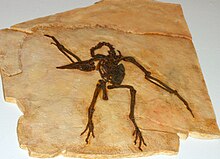| Lithornithidae | |
|---|---|

| |
| Pseudocrypturus cercanaxius fossil cast, Zoologisk Museum, Copenhagen | |
| Scientific classification | |
| Domain: | Eukaryota |
| Kingdom: | Animalia |
| Phylum: | Chordata |
| Class: | Aves |
| Infraclass: | Palaeognathae |
| Order: | †Lithornithiformes Houde, 1988 |
| Family: | †Lithornithidae Houde, 1988 |
| Genera | |
|
See text | |
Lithornithidae is an extinct, possibly paraphyletic[1] (but see below) group of early paleognath birds. They are known from fossils dating to the Upper Paleocene through the Middle Eocene of North America and Europe, with possible Late Cretaceous representatives.[1][2] All are extinct today;[3] the youngest specimen is the currently unnamed SGPIMH MEV1 specimen from the mid-Eocene Messel Pit site.[4]
Lithornithids had long, slender, bills for probing. They closely resembled modern tinamous, aside from more developed wings. They possessed a rhynchokinetic skull with relatively unfused cranial bones, a weakly fused pygostyle and a splenial. The unguals were more curved than in tinamous and probably allowed better perching in trees.
The order Lithornithiformes was erected by Dr. Peter Houde in 1988. Initially, only three genera (Lithornis, Paracathartes, and Pseudocrypturus) and eight named species were included.[3] Promusophaga (Harrison & Walker, 1977) originally considered a stem-turaco, is considered synonymous with Lithornis vulturinus. Fissuravis may also belong to the clade,[5] and several unnamed remains are known.
- ^ a b Paleogene Fossil Birds
- ^ A lithornithid (Aves: Palaeognathae) from the Paleocene (Tiffanian) of southern California
- ^ a b Houde, Peter W. (1988). "Paleognathous Birds from the Early Tertiary of the Northern Hemisphere". Publications of the Nuttall Ornithological Club. 22. Cambridge Massachusetts, USA: Nuttall Ornithological Club.
- ^ "First substantial Middle Eocene record of the Lithornithidae (Aves): A postcranial skeleton from Messel (Germany)" (PDF). Archived from the original (PDF) on 10 June 2011. Retrieved 11 June 2016.
- ^ Gerald Mayr, Paleogene Fossil Birds